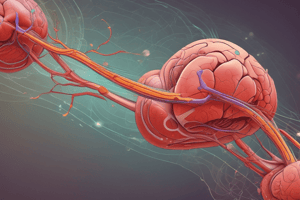Podcast
Questions and Answers
What is the average length of each kidney?
What is the average length of each kidney?
- 4-5 inches (correct)
- 2 inches
- 8-10 inches
- 6-7 inches
What is the primary function of the kidneys?
What is the primary function of the kidneys?
- To filter oxygen from the air
- To regulate body temperature
- To filter waste and excess fluids from the blood (correct)
- To regulate blood sugar levels
What is the name of the functional units of the kidneys?
What is the name of the functional units of the kidneys?
- Nephrons (correct)
- Kidney cells
- Glomeruli
- Renal units
What percentage of the total cardiac output does the kidneys receive?
What percentage of the total cardiac output does the kidneys receive?
What is the name of the system that regulates blood pressure?
What is the name of the system that regulates blood pressure?
What is the term for the gradual loss of kidney function over time?
What is the term for the gradual loss of kidney function over time?
What is the name of the small, hard mineral deposits that form in the kidneys?
What is the name of the small, hard mineral deposits that form in the kidneys?
What happens when the kidneys are no longer able to filter waste and excess fluids from the blood?
What happens when the kidneys are no longer able to filter waste and excess fluids from the blood?
Flashcards are hidden until you start studying
Study Notes
Kidney Structure
- The kidneys are two bean-shaped organs located in the lower back, one on each side of the spine.
- Each kidney is about 4-5 inches long and weighs about 0.25 pounds.
Kidney Function
- The kidneys filter waste and excess fluids from the blood.
- They regulate electrolyte levels, maintain acid-base balance, and regulate blood pressure.
- The kidneys also produce hormones that help produce red blood cells, promote bone health, and regulate blood pressure.
Nephrons
- The functional units of the kidneys are called nephrons.
- There are about 1 million nephrons in each kidney.
- Each nephron consists of:
- Glomerulus: a cluster of capillaries that filter the blood.
- Bowman's capsule: a double-layered sac that surrounds the glomerulus.
- Renal tubule: a narrow tube where reabsorption and secretion occur.
Kidney Blood Flow
- The kidneys receive about 20% of the total cardiac output.
- Blood flows into the kidneys through the renal arteries and out through the renal veins.
- The kidneys have a unique blood supply system, with two capillary beds: the glomerular capillaries and the peritubular capillaries.
Kidney Functions in Regulation
- Blood pressure regulation: the kidneys regulate blood pressure through the renin-angiotensin-aldosterone system.
- Electrolyte balance: the kidneys regulate electrolyte levels, such as sodium, potassium, and calcium.
- Acid-base balance: the kidneys help maintain acid-base balance by regulating hydrogen ion levels.
Kidney Diseases and Disorders
- Acute kidney injury (AKI): sudden damage to the kidneys.
- Chronic kidney disease (CKD): gradual loss of kidney function over time.
- Kidney stones: small, hard mineral deposits that form in the kidneys.
- Kidney failure: the kidneys are no longer able to filter waste and excess fluids from the blood.
Kidney Structure
- Kidneys are two bean-shaped organs, each about 4-5 inches long and weighing 0.25 pounds, located in the lower back on either side of the spine.
Kidney Function
- Filter waste and excess fluids from the blood.
- Regulate electrolyte levels, maintain acid-base balance, and regulate blood pressure.
- Produce hormones that help produce red blood cells, promote bone health, and regulate blood pressure.
Nephrons
- Functional units of the kidneys, with about 1 million in each kidney.
- Each nephron consists of a glomerulus, Bowman's capsule, and renal tubule.
- Glomerulus: a cluster of capillaries that filter the blood.
- Bowman's capsule: a double-layered sac that surrounds the glomerulus.
- Renal tubule: a narrow tube where reabsorption and secretion occur.
Kidney Blood Flow
- Receive about 20% of the total cardiac output.
- Blood flows into the kidneys through the renal arteries and out through the renal veins.
- Unique blood supply system with two capillary beds: glomerular capillaries and peritubular capillaries.
Kidney Functions in Regulation
Blood Pressure Regulation
- Regulate blood pressure through the renin-angiotensin-aldosterone system.
Electrolyte Balance
- Regulate electrolyte levels, such as sodium, potassium, and calcium.
Acid-Base Balance
- Help maintain acid-base balance by regulating hydrogen ion levels.
Kidney Diseases and Disorders
- Acute kidney injury (AKI): sudden damage to the kidneys.
- Chronic kidney disease (CKD): gradual loss of kidney function over time.
- Kidney stones: small, hard mineral deposits that form in the kidneys.
- Kidney failure: the kidneys are no longer able to filter waste and excess fluids from the blood.
Studying That Suits You
Use AI to generate personalized quizzes and flashcards to suit your learning preferences.



